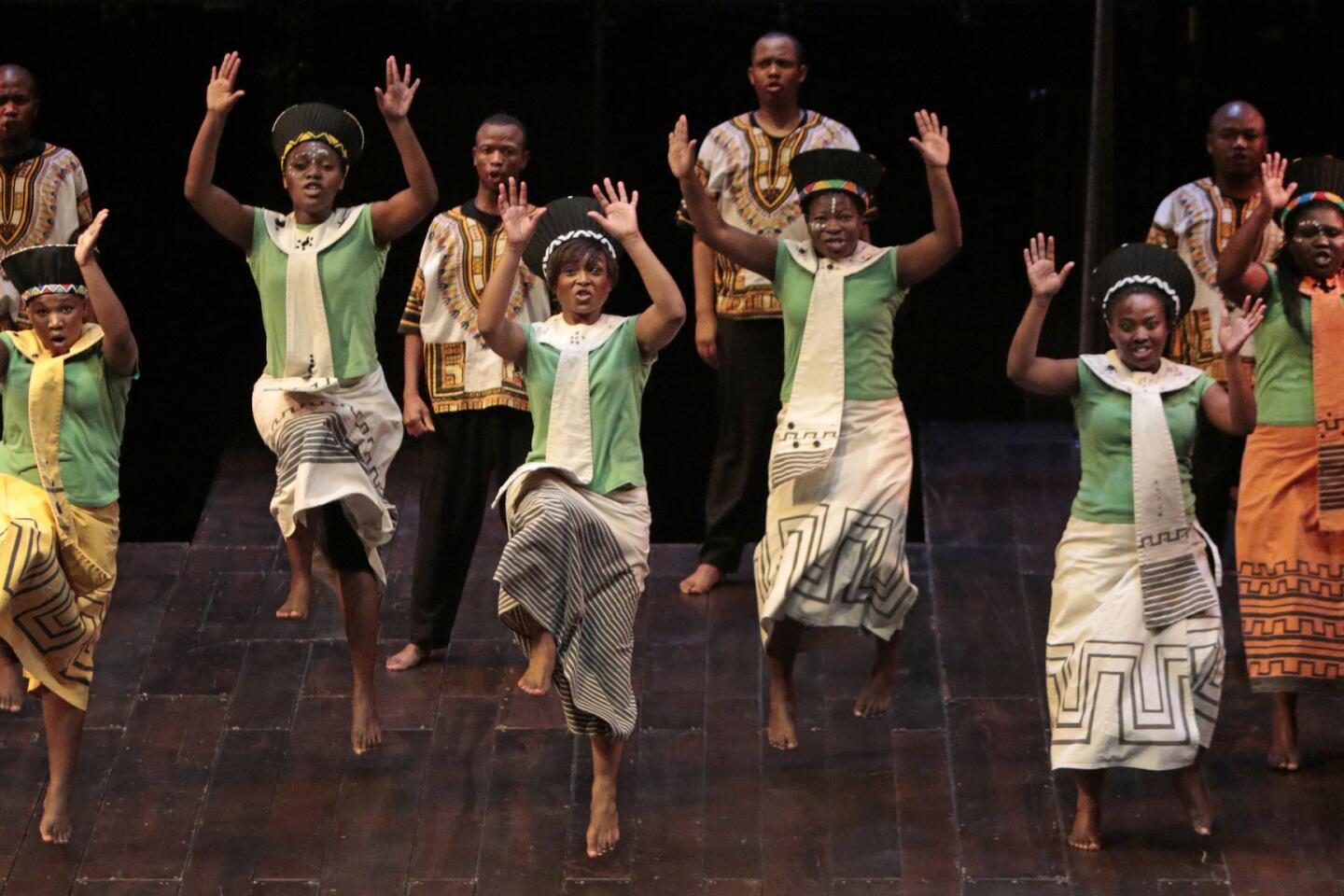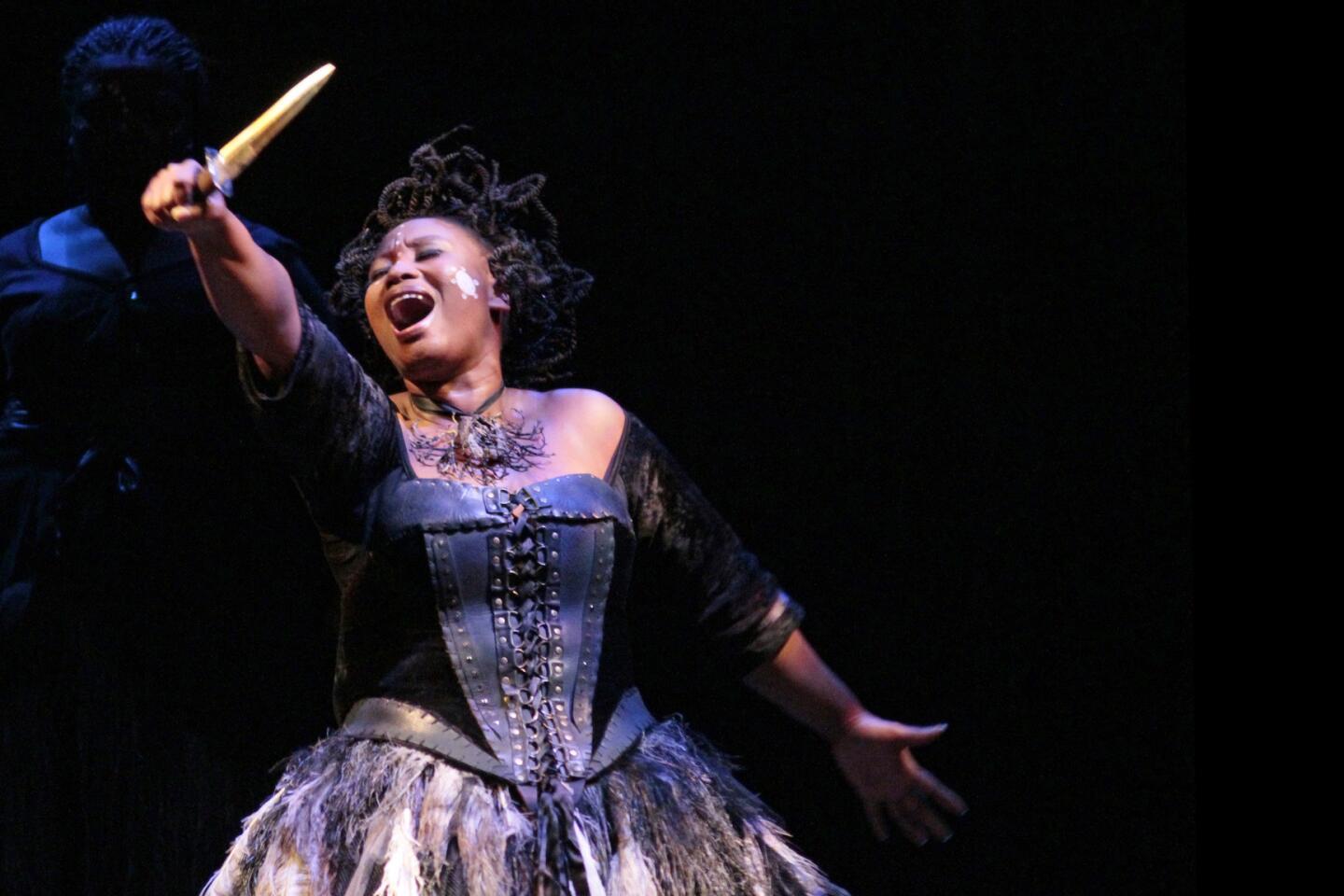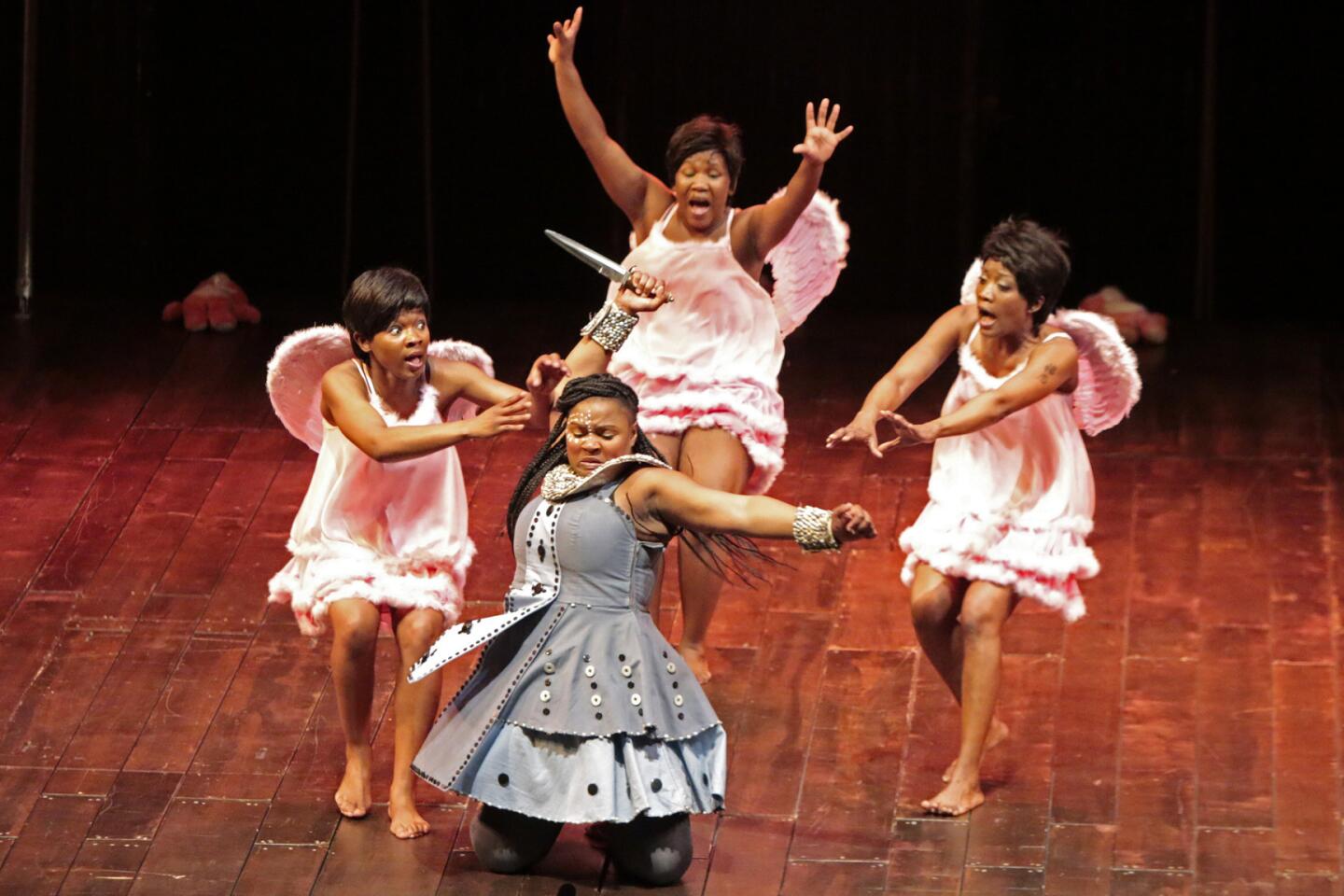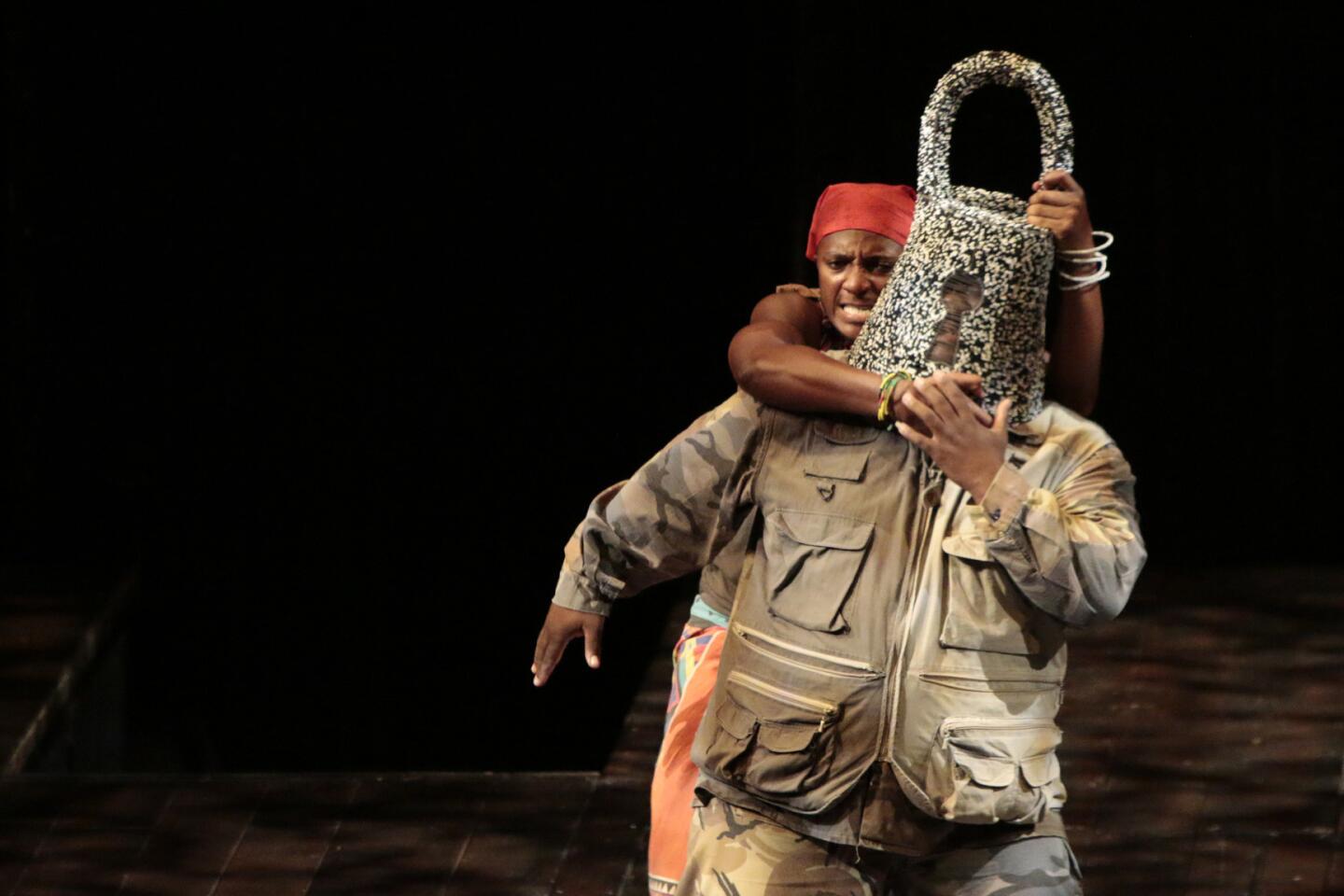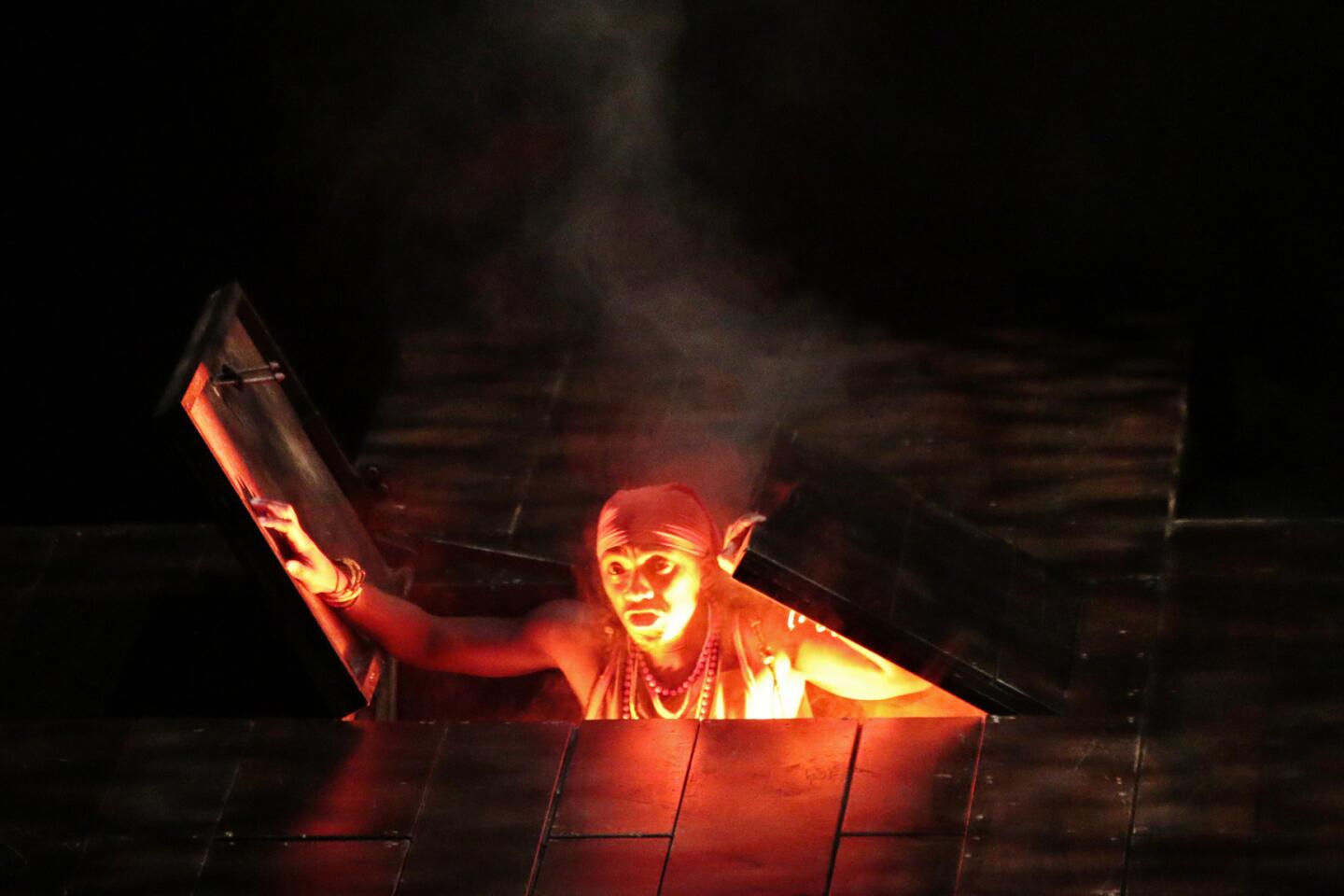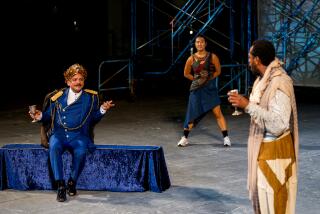Review: A ‘Flute’ from Africa renews Mozart’s musical magic
The Isango Ensemble, one of the world’s most unusual, interesting and important theater and opera companies, doesn’t distinguish between African theater and European opera. Nor does the company from Cape Town, South Africa, acknowledge barriers between African myth and European, African ritual and European, African music and European.
Isango’s marvelous newly magical “The Magic Flute,” which is touring the U.S. for the first time and opened at the Broad Stage in Santa Monica on Wednesday night for performances that run through Sunday, is Isango’s version alone. There is simply no opera and no Mozart like it.
The orchestra is made of up marimbas and drums and found instruments, and the percussionists dance and sometimes sing as they play buoyant transcriptions of Mozart’s score, all from memory. African choral tradition is invited. The opera is adapted in time, space, language and sound to Cape Town of today and also of tradition. Singers, who come from local townships, blend operatic style with their own conventions. Much authentic Mozart is retained, but the less authentic the better. What is new and different is what matters most.
In a program note, director Mark Dornford-May — who founded Isango in 2000 with singer and actress Pauline Malefane — notes the many similarities between the libretto of “The Magic Flute,” which was inspired by Masonic rites, and Tsonga tradition. Papageno (Mozart’s bird catcher), the Queen of the Night, Sarastro’s spiritualist tribe, the magic flute, the trial of fire and water and too much more to be coincidence, is found in timeless African folk tales.
So too does much music that we hear today — particularly in pop music and jazz — have deep roots in Africa. That goes for significant aspects of contemporary art music as well. Minimalism wouldn’t be the same without the influence of Ghanaian drumming. At the Los Angeles Philharmonic last week and this, new and recent percussion pieces by David Lang and Michael Gordon used bottles and trash cans, just as members of Isango do. Gordon and Lang also explored the exceptional qualities of hitting irregularly tuned wooden bars, and the unconventional tuning of Isango’s marimbas proved part of the magnificent musical mysteries in the “Flute.”
Dornford-May’s production begins with the music director Mandisi Dyantyis dressed in white T-shirt and cargo pants, standing at the front of the stage, back to the audience and facing a large screen, the marimbas arrayed on the two sides of the stage. With the screen projecting Dyantyis from the front, we see him conducting in a manner half-dance and 100% musical.
Dyantyis is a major discovery. His fluidity is a marvel, and it carried over from conducting to his dancingly brilliant marimba playing when he joined the ensemble. In a splendid coup-de-Mozart, Dyantyis also played a cool jazz trumpet as the sound of the magic flute.
The basis for Mozart’s opera, and most of its music, is retained but retrained. The libretto is translated into contemporary South African English with occasional forays into Xhosa and other African languages. There are no surtitles, and even the English can hard be to follow, spoken with heavy accents and sung without strong projection of text. The big problem with the production is that for all the immediacy of its song and dance or the thrill of Leigh Bishop’s captivating costumes, some in audience who didn’t know the work felt lost.
Still, the theatrical and musical invention is a show all its own. Tamino (Mhlekazi “Wha Wha” Mosiea) and Pamina (Zolina Ngejane), the innocent and likable young lovers and here Xhosa teenagers, are fully recognizable as Mozart’s characters. Papageno (Zamile Gantana), the comic bird catcher, is the jovial slacker found in all cultures. Sarastro (Ayanda Tikolo) logically becomes an imposing tribal leader. His exceptionally powerful version of “In diesen heil’gen Hallen” transformed into a solo ode to freedom with humming chorus is a downright Mandelaian moment.
The spiritualty is African, not Masonic. So too is much of the humor and pathos. The dance could come from nowhere else. Nowhere else, for certain, will you find a cast and orchestra in constant, evocative movement. Whether the performers are large or svelte makes no difference as to their lightness on their feet.
Only Malefane, a stately and commanding Queen of the Night gowned in feathers, is really at home with operatic technique. The others manage, some with stronger voices than others, and they shine more in the moments when the transcriptions are more in their own musical styles than Mozart’s.
But opera is the art of many arts, and this is a “Magic Flute” of more arts than we normally get. Isango’s greater feat, though, is that no one aspect exists apart from any other, and everything in the Mozart’s “Magic Flute” is made to seem personal, a reflection of the situations relevant to the lives of these performers.
The production has won international admirers and awards for its joyfulness. A little loud ululating over a Mozart chorus does wonders for a listener’s mood. But this is also a “Magic Flute” of defiance, of raised fists, of the celebration of freedom and equality that were Mozart’s ideals and are the often overlooked essence of the opera.
In the end, Isango’s is a surprisingly melancholic “Magic Flute.” Tamino’s smiles are seldom and not convincing. The lovers’ trials are not fanciful; you sense that something could go wrong at any moment. There is, in all Isango’s buoyancy, weightiness. The soulful trumpet of the magic flute is not magic sweet song but the blues. This most foreign “Magic Flute” is also the most real.
------------
‘The Magic Flute’
Where: Broad Stage, 1310 11th St., Santa Monica
When: 7:30 p.m. Friday and Saturday, 2 p.m. Saturday, 4 p.m. Sunday
Tickets: $49 to $120
Info: www.thebroadstage.com or (310) 434-3200
Running time: 2 hours, 10 minutes
More to Read
The biggest entertainment stories
Get our big stories about Hollywood, film, television, music, arts, culture and more right in your inbox as soon as they publish.
You may occasionally receive promotional content from the Los Angeles Times.

